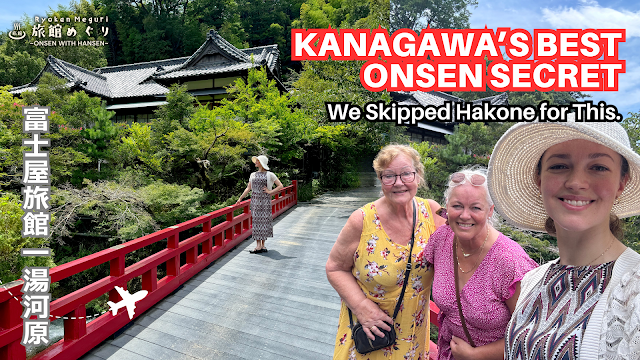I Stayed at 3 Real Life Japanese Inns That Inspired Spirited Away | Ghibli Pilgrimage Japan
You know that quiet moment when dusk settles in, and the air turns a little thicker with memory? In Japan, that moment often happens at a ryokan.
During one of my most recent journeys, I decided to follow not just a trail on the map—but a trail of wonder. A Ghibli trail, to be exact. And if you’re a fan of Spirited Away (aren’t we all?), this one might just make you book your next trip.
I visited three inns that are widely believed to have inspired Spirited Away’s magical bathhouse. Each one felt like a different kind of portal—one into craftsmanship, one into artistry, and one into something… a little otherworldly.
Kanaguya: Wood, Lanterns, and the Whisper of Spirits
The first stop was Kanaguya Ryokan in Shibu Onsen, tucked away in the mountains of Nagano. The moment I stepped through the wooden entrance, I felt like I had landed in the 1930s—and possibly also in another dimension.The ryokan’s crown jewel is the Seigetsuro, a four-story wooden masterpiece built entirely without nails. Every beam and balustrade was carved by hand, and at night, with the lanterns glowing and casting shadows down the creaky corridors, it was hard not to feel like soot sprites might be around the next corner.
Kanaguya doesn’t just look magical—it’s powered by it. The inn draws from nine different natural hot spring sources, which the current fourth-generation owner blends daily with a kind of alchemical care that’s almost poetic. I tried each of the indoor baths during my stay, and each felt slightly different—softer, lighter, deeper, like the water had mood swings.
And if you’re the type who enjoys a bit of ritual, the Shibu Onsen nine-bath pilgrimage is a must. I shuffled through town in my yukata and wooden sandals, little wooden key in hand, unlocking bathhouse doors one by one like I was collecting blessings.
Meguro Gajoen: The Dragon Palace Hiding in Tokyo
From quiet Nagano to the heart of Tokyo—it felt like I jumped timelines. Meguro Gajoen is not your average inn. It’s more like someone gave Japan’s best artisans a blank cheque and said, “Go wild.”
Originally opened in 1931, this place was once dubbed the Dragon Palace of the Showa Era. Walking through the Hyakudan Kaidan, the “100-Step Staircase,” I felt like I was in a fantasy film. Each of the connected banquet rooms is themed, and dripping with traditional arts: gold-leaf ceilings, mother-of-pearl inlays, hand-carved screens. It’s not subtle, but then again, neither is the bathhouse in Spirited Away.
Meguro Gajoen isn’t a ryokan in the traditional sense—you don’t sleep on tatami floors or wear a yukata here—but it is a preservation of cultural elegance, and walking through it made me feel oddly proud. Proud that spaces like this still exist in the chaos of a city like Tokyo.
Sekizenkan: Where Time Stretches and the Air Hums
Then there was Sekizenkan, in Shima Onsen. And this place… well. This place made me slow down without meaning to.
Founded back in 1691, Sekizenkan is one of Japan’s oldest ryokans, and stepping onto the red-lacquered bridge that connects the main building to the mountain annex felt like walking into a scene from a dream. At dusk, when the lanterns begin to glow and the water runs dark beneath the arch, it’s easy to understand why people say this was the bridge that inspired the one to the spirit world.
Their bathhouse, Genroku no Yu, is a marvel. Arched windows, tiled floors, and that soft, timeless echo of water dripping onto stone. I sat there longer than planned, letting my thoughts unravel.
There’s something about Sekizenkan that doesn’t try to impress—it just is. It has the kind of quiet dignity that makes you whisper without realizing it. And coming from a culture where silence can sometimes feel like space between thoughts, this place taught me that in Japan, silence is the thought.
A Glimpse Into Another Layer of Japan
As someone from the Nordics, I'm used to silence. But Japan's silence is different—more alive, more patient. These ryokans aren’t just accommodations. They’re portals. Each one showed me something deeper about Japan’s relationship with nature, time, and imagination.
If you’re looking to step beyond the Tokyo-Kyoto route and experience the kind of Japan that inspired the world’s most beloved animated film, these three inns belong on your map.
🎥 Want to See the Magic Come to Life?
I documented this journey in a video you can watch here:
👉 Watch: 3 Real-Life Ryokans That Inspired Spirited Away
Whether you're planning your next onsen stay, building a Ghibli travel itinerary, or simply dreaming of red bridges and lantern light, I hope it inspires you to go deeper into Japan.
Until next time—let's relax, rejuvenate, and rediscover Japan one ryokan at a time.























![[Hotel Review] Manila: A night at the Hotel H2O Aquarium Hotel](https://blogger.googleusercontent.com/img/b/R29vZ2xl/AVvXsEhr6Htjs5IkrblDNSVvN1nJq2VqYSfzGeM1ITy7xpQLjOt20kiZnCd1NHLKeavoQ-BOCUVp8ciWn-hykaK6LmWjsmEH1OM6RMz8qJzRNNtYfh6T-xtDT8s_GJSeeqjPNgQVdkB_wi9dZIiz/w72-h72-p-k-no-nu/IMG_5062.JPG)







